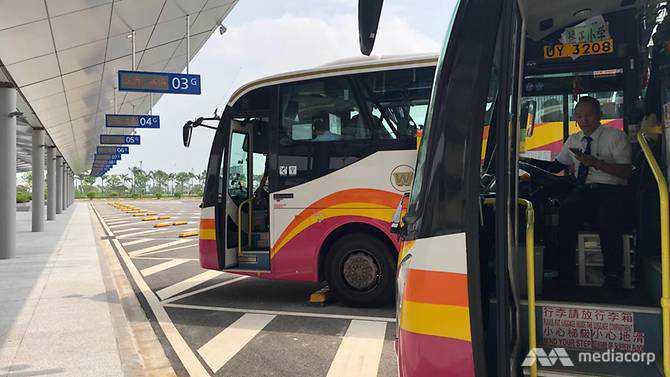Taking a bus across the world's longest sea bridge: A correspondent's view
25 October, 2018

On Wednesday (Oct 24), I rode on a bus across the world’s longest sea bridge - which connects Hong Kong, Macau and mainland China - and it was tedious.
"Hey have you heard the world’s longest sea bridge starts operations Wednesday? Wanna go have a look?"
"Yes, why not?" I thought - and so did dozens of other journalists.
For a bridge that cost US$18 billion, China surely wanted to see lots of people coming to the big unveil.
It was just before 9am, and the yet-to-open Hong Kong checkpoint was already besieged by crowds of people.
Most of them were bused in, led by flag-waving guides and wearing tags on their chests so they were easily identifiable to their group-mates.
Lots of photo-taking ensued, but strangely not a single suitcase was in sight.
No one was interested in any shopping? That is a distinctly strange phenomenon.
“We are organised by the DAB,” one affable old lady said.
The DAB is Hong Kong’s largest pro-Beijing political party.
“We only had to pay US$20 for this day trip to Zhuhai," she added.
Later, a young tour guide told me the US$20 goes a long way, covering not just the bus fee but also lunch and dinner (a much better deal than the one I got).
Since only a very lucky few have a permit to drive on the bridge - though none of them turned up that day - everyone has to depend on public transport to cross the bridge.
There is a shuttle bus, with a one-way trip costing just US$8.
But the bridge starts outside Hong Kong's airport, which itself is quite far out, so several coach companies also offer direct services to Zhuhai from various locations in downtown Hong Kong.
I should say I like bridges. Before he retired, my father was a civil engineer who worked on lots of bridges and tunnels, so I can get quite romantic about these really big things.
But soon, I realised the best spot from which to appreciate a bridge is definitely not from a speeding bus on the said bridge.
This is partially because - as is obvious - the bridge is really, really long.
After you leave Hong Kong and get out of the tunnel, the bridge makes only one bend, making the view rather static.
In addition, the notorious air pollution of the Pearl River Delta shrouds much of the bridge in smog and drains the colour out of everything.
In fact the drive is so tedious, mainland authorities are worried that the shuttle drivers might fall asleep.
That is reportedly why all the shuttle buses are equipped with "yawn cameras".
Three yawns by the driver, and authorities are alerted. The drivers are also said to have been asked to wear a heart rate sensor, which I truly cannot explain.
But fear not, anticipating your boredom, the private coaches come with free WiFi and USB charging ports. However, halfway across the bridge, Facebook freezes up.
That's because in mainland China, Facebook is banned, and you are in mainland China even before you clear the checkpoint.
On the mainland side, people seemed much more enthusiastic about the bridge.
Some brought their young babies out to snap a photo at the entrance. Many who have never been to Hong Kong now vowed to visit.
Inside the Chinese checkpoint, an officer tried to turn away two young men. Apparently they were so excited they booked bus tickets without getting a Hong Kong travel permit first.
“We were in a hurry, so we really didn’t think this through,” one of them said.
“Yes, we just wanted to see the bridge with our own eyes,” the other added.
They both looked like they were in their early 20s; optimistic and innocent. I did not have the heart to tell them they would be better off watching the bridge from their window.
In all, the Hong Kong-Zhuhai-Macau bridge appears a smooth operation that provides quite a bit of ease and convenience to Hong Kong residents who do not live on Hong Kong Island, an area already well-served by cross-border ferry services.
But it provides even more convenience to mainland tourists who want to come to Hong Kong - and they are either the lifeblood of the economy or the destroyer of civility in Hong Kong, depending on who you ask.
Meanwhile, the hundreds of people I saw earlier in the morning took just minutes to dissolve into a dozen buses, which in turn quickly disappeared into the distance.
For the most part, the bridge was quiet, lonely even.
But as my father always told me, new infrastructure projects are meant to be ahead of their time, because they will be around for a lot longer than we will.
TAG(s):
